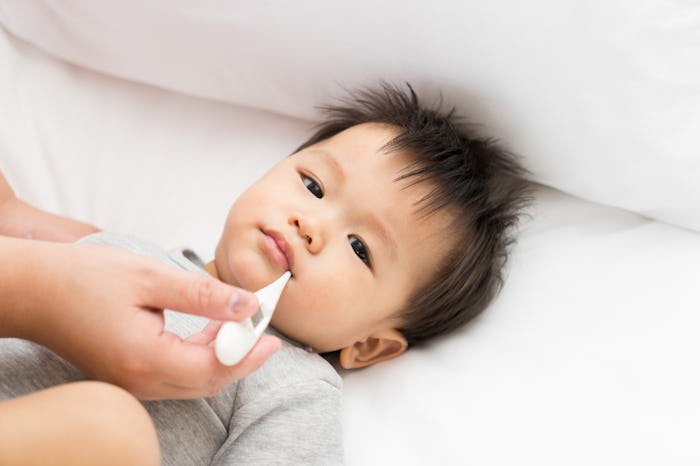Life

Here's What You Need To Know About Toddlers & Fevers
If you are a parent, words like “worst flu season” and “superbugs" might find you dreading winter. Dealing with yourself getting sick is hard enough, but when your little one gets sick, it's really tough. If my kids are sick, I often let their fever run in hopes that their body will fight off the virus. Many doctors say it is OK to let your child’s fever run, as long as it is low-grade. So if you have a little one with the sniffles, you may wonder, at what temperature is a fever dangerous for a toddler?
It turns out that toddlers are pretty resilient. In an interview with Romper, Pennsylvania pediatrician Dr. Jarret Patton says that toddlers can tolerate fever very well for their size, and although a fever is classified as a temperature of over 100.4 degrees Fahrenheit, in most cases, toddlers can withstand a temperature up to 104 degrees without much difficulty. With that said, Patton suggests that if your toddler’s fever reaches 104 degrees or above, or if their fever has lasted over 24 hours for kids under 2, or lasted longer than 72 hours for kids over 2, you should call their doctor or pediatrician for an evaluation.
Patton explains that when it comes to a fever, it’s really the cause that is the dangerous part, because a fever is just the expression of illness in children. “A viral illness with cough and congestion in a child with a temp of 103.5is less dangerous than a child with changes in behavior and a stiff neck (signs of meningitis) with a temperature of 102.5," he says. So you should always pay attention to the accompanying symptoms and contact your doctor if anything looks out of the ordinary.
It's also important to understand why children get fevers in the first place. According to the website for Ask Dr. Sears, your child’s immune system releases chemicals that raise their body temperature in order to fight off infections, which is a completely healthy and normal way for the body to respond to an illness. According to the American Academy of Pediatrics (AAP), a parent’s goal should be to make their child more comfortable, rather than to keep them at a “normal” temperature.
If your child is playful, eating well, and comfortable, the AAP’s Healthy Children website recommended avoiding fever reducers, and using methods like keeping your child in a cool room with light clothing, having them avoid overexertions, and giving them plenty of liquids to treat their fever. This is only an option if your child is otherwise healthy, the organization noted, and is not recommended if your child has a fever of over 104 degrees, has other concerning symptoms, or has a history of febrile convulsions or chronic disease. So it’s important to keep your pediatrician or doctor in the loop about your treatment plans.
Of course, if your child is in pain, you may need to rely on fever reducers to keep your child comfortable, and Patton suggests treating the fever with a weight-based dose of acetaminophen or ibuprofen. Just remember to consult their doctor before giving them any medication, and get a green light on the type and dosage you should use.
Fevers are just a part of life, and as a parent you will learn to gauge when your child is in the danger zone. If you are unsure or concerned, it never hurts to take your child in for a sick visit or to an urgent care clinic to make sure they are getting the right treatment for their situation.
Check out Romper's new video series, Romper's Doula Diaries:
Watch full episodes of Romper's Doula Diaries on Facebook Watch.